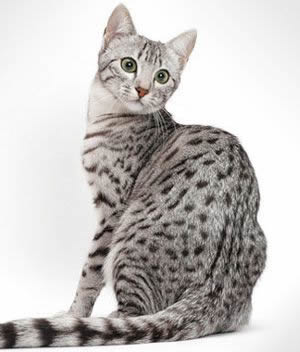Breed Standard
Head: Wedge-shaped with slightly rounded contours and no flat surfaces. Slightly rounded forehead. Slight stop or slope between the nose and forehead. The cheeks are not full, except in adult males. Muzzle neither short nor pointed. Nose as long as it is wide.
Eyes: Large, almond-shaped, neither round nor Oriental type, set at a slight slant. Light green, gooseberry green. Amber is allowed in young adults up to 18 months.
Neck: Very muscular and arched.
Body: Moderately long, between foreign and cobby types. High, angular shoulders. Heavy-boned. Very muscular.
Paw: Hind legs longer than forelegs. Muscular. Small, slightly oval paws.
Tail: Moderately long, thick at the base, tapering slightly to the tip.
Coat: Short, fine, silky, resilient, lying very flat against the body. At least two bands of ticking on the ground color. Coat naturally spotted tabby. Dark, round, evenly spaced spots on the trunk and belly. Stripes on the extremities. "M"; or scarab marking on the forehead, mascara lines on the cheeks, rings on the tail, broken necklace on the chest, and broken rings on the paws.
Fault: Round or short head. Small ears. Full cheeks, except in adult males. Muzzle too pointed or too short. Small, round, or Oriental type eyes. Amber eyes in cats over 18 months old. Massive or Oriental type body. Spots that are touching. Continuous necklaces.
History
This spotted cat with lovely mascara markings was deified in ancient times Mau is the Egyptian word for cat. In fact, the ancestors of this breed were protected, worshipped, and represented on the monuments of ancient Egypt. Nathalie Troubetskoy, a Russian princess exiled in Italy, obtained Egyptian Maus from Cairo in 1953, including a female named Baba and a kitten named Lisa who were shown in Rome in 1955. In 1956, when the princess emigrated to the United States, she brought her cats and founded the Fatima Cattery. Baba was awarded in 1957. This rapid success encouraged others to breed Egyptian Maus, and the breed was recognized by the C.F.A. and by T.I.C.A., which published a standard in 1988. That same year, the Egyptian Mau was also bred in Europe, where it is still quite uncommon. The F.I.Fe. approved the breed in 1992. The spotted tabby Oriental Shorthair, developed in Britain, is often mistaken for the Egyptian Mau.
Behavior
Lively, playful, active, and well-balanced, Egyptian Maus are neither aggressive nor nervous. They do not like agitation. Reserved toward strangers and sociable around other cats, they are gentle and very affectionate toward their owner. They have a soft, pleasant voice. They require only weekly brushing.
Health
Heart Disease, Luxating Patella, and extreme sensitivities to anesthetics, vaccines, and pesticides.






